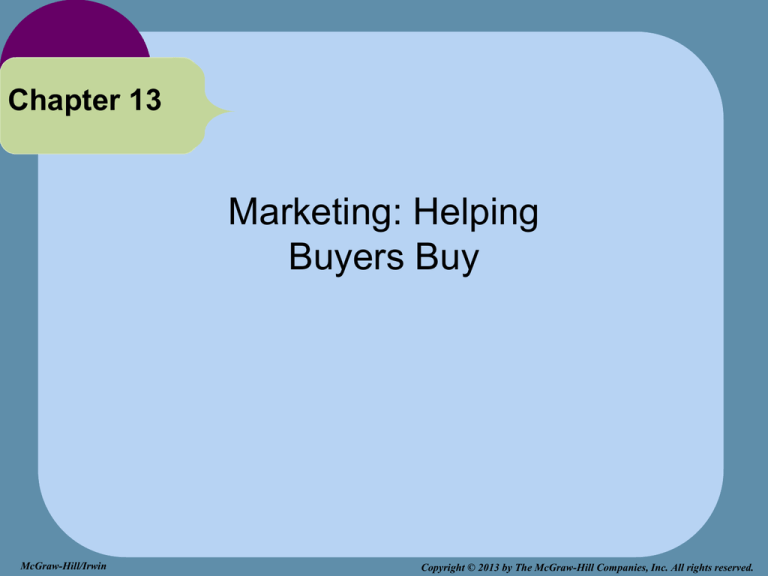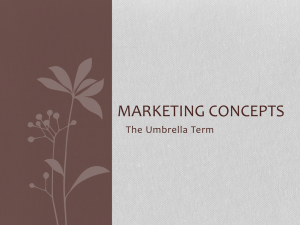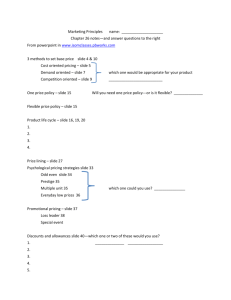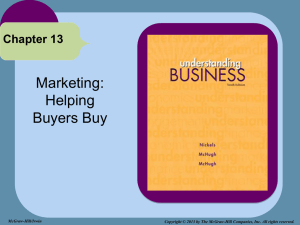
Chapter 13
Marketing: Helping
Buyers Buy
McGraw-Hill/Irwin
Copyright © 2013 by The McGraw-Hill Companies, Inc. All rights reserved.
What is
Marketing?
WHAT’S MARKETING?
LG1
• Marketing – Marketing is the activity, set of
institutions
and
processes
for
creating,
communicating, delivering, and exchanging offerings
with value for customers, clients, partners, and
society at large.
13-2
What is
Marketing?
LG1
FOCUS of CONTEMPORARY
MARKETING
• Marketing today involves helping the buyer buy
through:
- Websites that help buyers find the best price,
identify product features, and question sellers.
- Blogs and social networking sites that cultivate
consumer relationships.
13-3
The Evolution
of Marketing
FOUR ERAS of U.S. MARKETING
LG1
• Production Era
• Selling Era
• Marketing Concept Era
• Customer Relationship
Era
13-4
The Evolution
of Marketing
LG1
The PRODUCTION and
SELLING ERAS
• The general philosophy
was “Produce what you
can because the market
is limitless.”
• After mass production,
the focus turned from
production to
persuasion.
13-5
The Evolution
of Marketing
The MARKETING CONCEPT ERA
LG1
• After WWII, a consumer spending boom
developed.
• Businesses knew they needed to be responsive
to consumers if they wanted their business.
13-6
The Evolution
of Marketing
LG1
APPLYING the
MARKETING CONCEPT
• The Marketing Concept includes three parts:
1. Customer Orientation -- Finding out what
customers want and then providing it.
2. Service Orientation -- Making sure everyone in
an organization is committed to customer
satisfaction.
3. Profit Orientation -- Focusing on the goods and
services that will earn the most profit.
13-7
The Evolution
of Marketing
LG1
The CUSTOMER
RELATIONSHIP ERA
• Customer Relationship Management (CRM) -Learning as much as you can about customers and
doing what you can to satisfy or exceed their
expectations.
• Organizations seek to enhance customer
satisfaction building long-term relationships.
13-8
Nonprofit
Organizations
and Marketing
NONPROFIT MARKETING
LG1
• Nonprofit marketing tactics include:
- Fundraising
- Public Relations
- Special Campaigns
- Ecological practices
- Changing public opinions and
attitudes
- Increasing organizational
membership
13-9
Nonprofit
Organizations
and Marketing
LG1
MARKETING STRATEGIES for
NONPROFITS
• Nonprofit marketing strategies include:
- Determine the firm’s goals and objectives
- Focus on long-term marketing
- Find a competent board of directors
- Exercise strategic planning
- Train and develop long-term volunteers
- Carefully segment the target market
13-10
The Marketing
Mix
The FOUR P’s
LG2
13-11
The Marketing Process
Find opportunities
Conduct Research
Identify a target market
Design a product to meet the need based on research
Do product testing
Determine a brand name, design a package, and set a price
Decide the placement /distribution area of product
Design a promotional program
Build a relationship with customers
Designing a
Product to Meet
Consumer
Needs
DEVELOPING a PRODUCT
LG2
• Product -- A good, service, or idea that satisfies a
consumer’s want or need.
• Test Marketing -- Testing
product concepts among
potential product users.
• Brand Name -- A word,
letter, or a group of words
or letters that differentiates
one seller’s goods from a
competitor’s.
13-13
Setting an
Appropriate
Price
LG2
PRICING and
PLACING a PRODUCT
• Pricing products depends on many factors:
- Competitors’ prices
- Production costs
- Distribution
- High or low price strategies
• Middlemen are important in place strategies
because getting a product to consumers is
critical.
13-14
Pricing Objectives
1) Achieving a target return on investment or
profit
2) Building traffic
3) Achieving greater market share
4) Creating an image
5) Furthering social objectives
Basic Pricing Strategies
• Cost-Based pricing – A strategy, that measures
cost of producing a product including materials,
labor, and overhead.
• Demand-Based Pricing– Target costing is
demand based which refer to designing a product
that satisfies customers and meets the firm’s targeted
profit margins.
• Competition-Based Pricing -- A strategy based
on what the competitors are charging for its products.
Analysis before Price Setting
• Break-Even Analysis -- The process used to
determine profitability at various levels of sales. The
break-even point is where revenues equals cost.
BEP= Total Fixed Cost/(Price of one Unit – Variable
Cost of one Unit)
• Total Fixed Costs -- All costs that remain the same
no matter how much is produced or sold.
• Variable Costs -- Costs that change according to
the level of production.
Other Pricing Strategies
• Skimming Price Strategy -- Pricing new products
high to recover costs and make high profits while
competition is limited.
• Penetration Price Strategy -- Pricing products
low with the hope of attracting more buyers and
discouraging other companies from competing in the
market.
• Everyday Low Pricing (EDLP) -- Setting prices
lower than competitors and then not having any
special sales.
Other Pricing Strategies (cont..)
• High-Low Pricing -- Using regular prices that
are higher than EDLP stores, but having many
special sales where the prices are lower than
competitors.
• Psychological Pricing -- Pricing products at
price points that make a product seem less
expensive than it is.
Developing an
Effective
Promotional
Strategy
PROMOTING the PRODUCT
LG2
• Promotion -- All the techniques sellers use to
inform people about their products and motivate them
to purchase those products.
• Promotion includes:
- Advertising
- Personal selling
- Public relations
- Word of mouth
- Sales promotions
Photo Courtesy of: Uri Baruchin
13-20
Promotional Tools
• Advertising: It is a paid, non-personal
communication through various media by
organizations and individuals who are in
some way identified in the advertising
message.
• Personal Selling: The face-to face
presentation and promotion of goods and
services.
Promotional Tools (cont…)
Public Relations: The management function that
evaluates public attitudes, changes policies and
procedures in response to the public’s requests,
and executes a program of action and information
to earn public understanding and acceptance.
The steps in good public relation program:
Listen to the public.
Change policies and procedures.
Inform people that you’re being responsive to
their needs.
Promotional Tools (cont…)
• Sales Promotion: The promotional tool that
stimulates consumer purchasing and dealer
interest by means of short-term activities.
B2 B sales promotion techniques:
• Trade Shows, Portfolios, Deals, Catalogs, Conventions
B2C sales promotion techniques:
• Coupons,
Cents-off
Promotions,
Sampling,
Premiums, Sweepstakes, Contests,
Bonuses,
Catalogs, Demonstrations, Special Events, Lotteries,
In-store Displays
Providing
Marketers with
Information
SEARCHING for INFORMATION
LG3
• Marketing Research -- Analyzing markets to
determine challenges and opportunities, and finding
the information needed to make good decisions.
• Research is used to identify products consumers
have used in the past and what they want in the
future.
• Research uncovers market trends and attitudes
held by company insiders and stakeholders.
13-24
The Marketing
Research
Process
LG3
FOUR STEPS in the MARKETING
RESEARCH PROCESS
1. Defining the problem or opportunity and
determining the present situation.
2. Collecting research data: Primary/Secondary
Through Survey/FGD
3. Analyzing the data.
4. Choosing the best solution and implementing it.
13-25
The Marketing Environment
•
•
•
•
•
Global factors
Technological factors
Sociocultural factors
Competitive factors
Economic factors
Two Different
Markets:
Consumer and
B2B
LG4
The CONSUMER and
B2B MARKET
• Consumer Market -- All the individuals or
households that want goods and services for
personal use and have the resources to buy them.
• Business-to-Business
(B2B) -- Individuals and
organizations that buy goods
and services to use in
production or to sell, rent, or
supply to others.
13-27
The Consumer
Market
MARKETING to CONSUMERS
LG5
• The size and diversity of the consumer market
forces marketers to decide which groups they
want to serve.
• Market Segmentation -- Divides the total market
into groups with similar characteristics.
• Target Marketing -- Selecting which segments an
organization can serve profitably.
13-28
Segmenting
the Consumer
Market
LG5
SEGMENTING the CONSUMER
MARKET
• Geographic Segmentation -- Dividing the market
by cities, counties, states, or regions.
• Demographic Segmentation -- Dividing the
market by age, income, education, and other
demographic variables.
• Psychographic Segmentation -- Dividing the
market by group values, attitudes, and interests.
(continued)
13-29
Segmenting
the Consumer
Market
LG5
SEGMENTING the CONSUMER
MARKET
(continued)
• Benefit Segmentation -- Dividing the market
according to product benefits the customer prefers.
• Volume (Usage) Segmentation -- Dividing the
market by the volume of product use.
13-30
Reaching
Smaller Market
Segments
LG5
MARKETING to
SMALL SEGMENTS
• Niche Marketing -- Identifies small but profitable
market segments and designs or finds products for
them.
• One-to-One
Marketing-- Developing
a unique mix of goods
and services for each
individual consumer.
13-31
Moving Toward
Relationship
Marketing
LG5
MASS MARKETING vs.
RELATIONSHIP MARKETING
• Mass Marketing -- Developing products and
promotions to please large groups of people.
• Relationship Marketing-- Rejects the idea of
mass production and focuses toward custom-made
goods and services for customers.
13-32
Moving Toward
Relationship
Marketing
KEYS to SUCCESSFUL RELATIONSHIP
MARKETING
LG5
• Effective relationship marketing is built on:
- Open communication
- Consistently reliable service
- Staying in contact with customers
- Trust, honesty, and ethical behavior
- Showing that you truly care
13-33
The Consumer
Decision-Making
Process
LG5
STEPS in the CONSUMER
DECISION-MAKING PROCESS
1. Problem recognition
2. Search for information
3. Evaluating alternatives
4. Purchase decision
5. Postpurchase evaluation
13-34
The Consumer
Decision-Making
Process
LG5
The CONSUMER DECISION MAKING
PROCESS AND OUTSIDE INFLUENCES
13-35
The Consumer
Decision-Making
Process
LG5
KEY FACTORS in CONSUMER
DECISION-MAKING
• Learning
• Reference Groups
• Culture
• Subcultures
• Cognitive Dissonance
Photo Courtesy of: Peter Hilton
13-36







